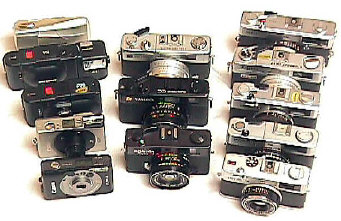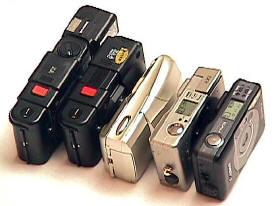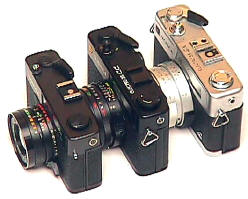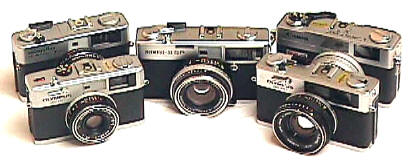Why Review These Cameras?
The article's basic interest is compact 35mm Rangefinders
with faster than f/2 lenses--in other words low light candid photography on a
budget. The core group
meeting this criteria are the Olympus RD, Canon G-III 17, Konica S3, Yashica
Electro 35 CC, Minolta 7sII and Yashica 35GX. The Olympus SP is slightly larger, but
uniquely has a spot metering system.
The second group of cameras is the "smaller is
better" crowd represented by the classic Rollei 35S,
Olympus XA and XA4.
Some may gripe that I excluded the Minox 35 series.
I just don't like them. Aesthetically they are ugly plastic things, and
from a practical standpoint they have weird batteries which are difficult to find
today. Worse than that, their flashes are bigger than the cameras. ugh.
I will admit though, many have told me what fine picture takers they are, and they do have
a lot of admirers. See "In Defense of Minox 35's"
What might be the most famous compact 70's rangefinder is
not reviewed yet, the Canonet 28 of the film cult classic "Pecker."
-- no its not a porn film, See film profile
Compacts 70's fast lensed 35's are different
from today's cameras:
-
Small bodied METAL cameras
instead of today's all plastic wonders.
-
All are Rangefinders, allowing
the photog to determine the precise point of focus
-
All are available light cameras with faster than f/2
lenses. This is important from today's standpoint, since no
modern day compact Point and Shoot has a f/2 or faster lens.
-
Some offer accurate Guide Number electronic flash exposure--which can easily be more accurate than TTL flash since it can't be
fooled by off grey subjects. Note you do not need special flash units to take
advantage of the GN systems!
-
ALL offer flash sync at all speeds, up to 1/500th.
-
Most offer a PC connection or hot shoe, or both.
With a sophisticated strobe like the Nikon SB25,
you can turn out some nice flash shots with these little cameras, well beyond what
they were ever intended for.
-
ALL have manually set ASA settings, allowing the photog to make exposure compensations.
-
All have mechanical shutters and still take pics if
the battery dies, except the Yashica Electro 35CC with
its electronic shutter.
-
None have built in flash. All are designed for separate flash units.
-
None have TTL metering,
but all have built in meters, something many of the classic rangefinders
lack.
-
None have motorized film advance or rewind.
-
ALL allow the photog more control of the picture process than today's compact P/S cams.
My 70's Favorites:
-
Most Features in the smallest package: Olympus RC
-
Most Capable: a tie between
the Olympus RD and Canon G-III 17
-
Best RF/VF of the test group:
Olympus RC/RD when cleaned, Yashica Electro 35 CC
-
Most useful focal length and f/stop of the test group: the 35/1.8 of the Yashica Electro 35 CC
-
Best Compact RF with fast lens and manual over-ride, a
tie: Olympus RD and Canon G-III 17
-
Best Guide Number Flash system: Konica S3 which balances ambient light
-
Easiest to carry: Olympus XA
and XA4 with their clamshell covers
-
Most retro mechanical look: Rollei
35's -- all models
-
Best camera for metering complicated lighting: Canon T90 with up to 9 multiple spot readings. OK, so it's not in
the test group. Hell, it's not even a RF. But it is the best for that
situation if you want to make your own decisions and not leave it to the camera to choose
for you. The truth is all these cameras have rather basic meters
compared to the wonders of today. Yet they will still turn out great pics if a
good photog is behind them.
- Favorite Fast Lensed Compacts:
The Olympus RD, Canon G-III 17, Konica S3, and Yashica Electro 35CC, in no
particular order. The RD has a great AE flash system and overall design. The
G-III has parallax compensation and the soundest construction feel. The
35CC has the most useful 35/1.8 lens and very nice VF/RF. The S3 has the most
advanced GN flash system built into a compact RF, and a very nice viewfinder /
rangefinder.
How Easily Can You Find these cameras? my experience in the US used market:
Easy to Find: Canon
G-III 17, Rollei 35's (a group comment, some are very rare), Olympus XA and RC,
Konica S series, most of the Yashica fixed lens rangefinders
Very Hard to Find: Olympus
RD, Yashica Electro 35CC and 35GX, Olympus XA4, Minolta 7sII, Olympus SP.
Personally I encounter about 25 Canon G-III 17's for every camera in this group.
Hardest to Find: Konica S3
and black enamel G-III 17.
Disadvantages: Age and Dimmer Finders
All of the 70's cameras listed here were comparatively
inexpensive when new. They were not designed to be as tough or as well sealed as
Leica M's or Nikon F2's. Translation: if you plan to use one on a
regular basis, it's a good idea to have the shutter serviced
and the VF/RF cleaned. It can make a BIG
difference. Even with the service, you will still have a bargain in terms of
bucks Vs performance.
This is important, so I'm going to repeat it. These
70's cameras were comparatively modestly priced and not well sealed against dirt.
After 30 years, the finders usually fog or haze up. Sometimes a little,
sometimes a lot. Do not use one of these on a regular basis without making
sure the finder is as clean as it gets. Case in point, I thought I had a
relatively clean Olympus RD and RC finder. I had them cleaned anyway
when I was doing a shutter lubrication. It made ALL the difference,
turning OK finders into bright very usable finders.
My Not So Favorites
- It just escapes me why photogs would choose the various
Spartan Rollei 35's when there are so many other small
cameras with so many more features...most of them costing much less. Strangely, the
Rollei 35's are by far the best selling of this nostalgic group. Of course I
am told they have wonderful lenses, but I like to take pics EASILY.
At least I can find solace in knowing this is the first time I
have ever gone against the majority of photographic opinion....well, maybe the second
time. If you like the Rollei 35's, take a look at the Petri Color
35's. The lens may not be up to Zeiss quality, but the design is. It's the
camera the Rollei 35 should have been.
- Minox 35's: I
just don't like the design, though they can take great pics.
Lens Performance
- That's easy, I'm not sure yet.
That will be an interesting story since I do not like lens testing and do not much believe
in it, unless you are testing your own specific equipment. That story, with it's
methods and it's logic, will be a future story.
Can Any of These Cameras Really
Compete with Leica M?
In some areas, Yes.
The 70's cameras offer electronic flash
sync at all speeds to 1/500th. The M's fastest sync is a paltry 1/60th.
Some of the 70's RF's offer guide number
flash control, which can be more accurate than TTL flash. Leica has
never offered guide number flash control, and only very recently offered TTL flash.
Some of the 70's RF's lenses are quite
sharp, sharp enough to compete even if they can't win.
You can buy approximately ten billion 70's era 35 RF's for the cost of a complete new Leica M outfit.
Even if you own a nice Leica M outfit,
sometimes you may want to take a smaller, less expensive camera.
-
QUIET, SHUSH! As
wonderfully quiet as the Leica M series are, all of these leaf shutter
rangefinders are quieter!
I chose a blend of the old and new
with this group, pitting the best of the compact
35's of the late 70's with two of today's best compacts, the Canon ELPH and the Olympus
Stylus Epic. I'm also a fan of the Canon ELPH Jr., with it's aspheric 2.8
lens. All offer the photog a variety of different features, in different
packages to suit different needs.



